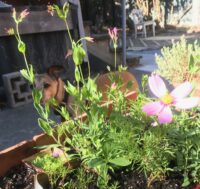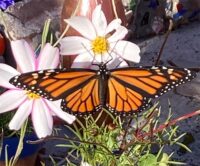When it comes to creating a lush garden that’s a safe haven for your furry friends, knowing which plants are safe and which could pose a danger is crucial. As a pet owner, the last thing you want is to unintentionally harm your beloved dog or cat with toxic plants. Thankfully, cosmos flowers are a fantastic choice that brings vibrancy to your garden without the worry.
Key Takeaways
- Cosmos flowers are non-toxic and safe for both dogs and cats.
- It’s important to choose pet-friendly plants to avoid accidental poisoning.
- Creating a pet-safe garden involves strategic plant placement and using barriers.
- Maintain a healthy garden with pet-friendly pest control methods.
- Know the signs of plant toxicity in pets and what to do if ingestion occurs.

Cosmos: A Pet-Friendly Addition to Your Garden
Let’s dive into why cosmos are the perfect addition to your pet-friendly garden. These cheerful blooms not only add a splash of color but also peace of mind, as they are completely non-toxic to both dogs and cats. They’re easy to grow and maintain, making them an excellent choice for both novice and seasoned gardeners.
Why Choosing Non-Toxic Plants Matters
Our pets are curious by nature, often sniffing and sometimes nibbling on plants. This natural behavior can lead to accidental ingestion of toxic plants, which can be harmful or even fatal. Therefore, it’s vital to choose non-toxic plants for your garden, ensuring that your pets can explore their outdoor environment safely.
The Safety Profile of Cosmos Plants
Cosmos plants stand out as an ideal choice for a pet-safe garden. They are known for their lack of toxins, making them a worry-free option for pet owners. All parts of the cosmos plant, including the flowers, leaves, and stems, are safe if ingested by your pets.
But why take my word for it? According to veterinarian Joanna Woodnutt, cosmos are not only non-toxic but also safe for canine consumption. This means you can enjoy the beauty of these flowers without the fear of them harming your pets.
As Joanna Woodnutt confirms, “Cosmos plants are not poisonous to your pup and are totally safe for canine consumption.”
Most importantly, while cosmos are safe, it’s essential to remember that not all plants are pet-friendly. Therefore, when planning your garden, it’s important to research each plant thoroughly to ensure they pose no risk to your four-legged family members.
Strategic Plant Placement to Prevent Pet Accidents
Designing a garden with pets in mind means more than just choosing the right plants. It’s also about placing them strategically to minimize risks. For instance, placing cosmos and other non-toxic plants around the perimeter of your garden can create a natural barrier, discouraging pets from venturing into areas with less safe plants. Additionally, consider the height and growth pattern of plants; keeping larger, bushier plants towards the back can prevent pets from trampling through more delicate varieties.
Using Barriers Effectively for Pet Restriction
Sometimes, despite our best efforts, pets have a way of getting into places they shouldn’t. To protect both your pets and your plants, use barriers such as small fences or decorative borders. These not only add to the aesthetic of your garden but also act as a gentle reminder to your furry friends that certain areas are off-limits.
Remember, the goal isn’t to keep your pets out entirely, but to create a space that is safe and enjoyable for everyone. By using barriers thoughtfully, you can ensure that your garden remains a sanctuary for all your family members, whether they have two legs or four.

Maintaining Your Pet-Friendly Garden
A pet-friendly garden requires regular maintenance to keep it safe and inviting. This includes monitoring plant health, managing pests, and ensuring that the environment remains non-toxic for your pets. Healthy plants are less likely to attract pests and diseases, which in turn reduces the need for chemical treatments that could be harmful to pets.
Dealing with Pests without Harsh Chemicals
When pests do make an appearance, opt for pet-safe alternatives to chemical pesticides. Natural solutions like neem oil, insecticidal soaps, or introducing beneficial insects like ladybugs can manage pest populations without putting your pets at risk. Always check the label of any product to confirm it’s safe for use around animals.
Regular Checks for Plant Health and Pet Safety
Consistent checks are key to a thriving pet-safe garden. This means inspecting plants for signs of stress or damage, which can attract pests or lead to decay. Remove any hazardous debris, like thorns or sharp sticks, that could injure your pet. If you have any concerns about a plant’s safety, it’s best to remove it altogether.
Understanding Potential Risks
Even with all the precautions in place, it’s important to be aware of the potential risks that come with having pets and plants coexist. While cosmos are safe, other plants might not be, and it’s critical to recognize the signs of toxicity should your pet ingest something harmful.
Common symptoms of plant toxicity can include vomiting, diarrhea, drooling, lethargy, or changes in appetite. If you observe any of these symptoms, it’s important to act quickly.
It’s also worth noting that certain plants may cause a mild reaction, such as skin irritation, even if they’re not toxic when ingested. Therefore, keeping a close eye on your pets’ behavior and physical condition is always a good practice.
Common Symptoms of Plant Toxicity in Pets
If your pet has ingested a toxic plant, they may exhibit symptoms such as:
- Excessive drooling or salivation
- Vomiting or diarrhea
- Loss of appetite
- Lethargy or weakness
- Difficulty breathing
Knowing these signs can help you act swiftly and seek veterinary care if needed.
Preventive Measures to Keep Your Garden Safe
Besides choosing the right plants and maintaining your garden, there are other preventive measures you can take:
- Research plants before adding them to your garden.
- Regularly train and supervise your pets in the garden to prevent unwanted chewing.
- Store garden chemicals, if used, out of reach of pets.
By taking these steps, you can create a garden that’s not only beautiful but also a safe playground for your pets.
When Pet Meets Plant: What to Do
Even with the most careful planning, accidents can happen. If you suspect your pet has ingested a potentially harmful plant, it’s crucial to act immediately.
Immediate Steps Following Suspected Ingestion
Here’s what to do if you think your pet has eaten something they shouldn’t have:
- Remove any plant material from your pet’s mouth.
- Observe your pet closely for any signs of distress.
- Contact your veterinarian or an emergency animal hospital right away.
- Bring a sample of the plant with you to the vet if possible.
Quick action can make all the difference, so don’t hesitate to seek professional help if you’re concerned about your pet’s health.
When Pet Meets Plant: What to Do
It’s a sunny day, and your garden is blooming with vibrant cosmos. Your pets are happily exploring, but then you catch your pup nibbling on some foliage. What do you do when the unthinkable happens, and your pet consumes a plant? Let’s walk through the steps to ensure their safety.
First, don’t panic. Remember, cosmos are non-toxic to pets. But, it’s always good to be cautious and monitor your pet for any unusual behavior. If you’re not sure what plant your pet has ingested, or if they’re showing signs of distress, it’s time to take action.
Immediate Steps Following Suspected Ingestion
If you suspect your pet has eaten a plant, take a deep breath and assess the situation. Check their mouth for any remaining pieces of the plant and remove them gently. Keep an eye on your pet’s behavior – are they acting differently? Do they seem uncomfortable or unwell?
Even though cosmos are safe, if you notice anything out of the ordinary, it’s better to be cautious. If your pet has consumed a large amount of any plant, it could cause an upset stomach purely due to the volume of roughage.
If you have any doubts about the plant your pet has eaten, or if they start to show symptoms like vomiting or diarrhea, it’s time to call your vet. They’ll be able to give you the best advice on what to do next.
- Keep calm and remove any plant material from your pet’s mouth.
- Watch for any signs of distress or unusual behavior.
- Contact your veterinarian or a pet poison helpline if you’re concerned.
- Provide your vet with information about the plant your pet has ingested.
When to Call the Vet
It’s always better to be safe than sorry when it comes to the health of your pets. If you notice any of the following symptoms after your pet has ingested a plant, call your vet immediately:
- Vomiting or diarrhea
- Excessive drooling
- Difficulty breathing
- Lethargy or weakness
- Seizures
These could be signs of toxicity, and prompt veterinary attention is crucial.
FAQ
How Do I Know if a Plant is Safe for My Pet?
To determine if a plant is safe for your pet, do your research before bringing it into your home or garden. Look for information from reliable sources such as the ASPCA’s list of toxic and non-toxic plants. When in doubt, consult with your veterinarian.
Keep in mind that some plants may be safe for dogs but not for cats, and vice versa. Therefore, it’s important to consider all your pets when choosing plants for your garden.
Can Cosmos Plants Affect My Pet’s Health?
Cosmos plants are generally safe and do not pose a risk to your pet’s health when ingested. These delightful flowers can be enjoyed without the worry of toxicity. However, any plant material, if consumed in large amounts, could potentially cause an upset stomach in some pets.
What Should I Do If My Pet Eats a Potentially Toxic Plant?
If your pet eats a potentially toxic plant, it’s important to act quickly. Remove any remaining plant material from their mouth, keep them calm, and contact your veterinarian or the nearest animal emergency clinic immediately. Be ready to provide details about the plant and the amount consumed.
It’s a good idea to keep a sample of the plant or take a photo to show to the veterinarian. This can help with quick identification and treatment.
Are There Certain Varieties of Cosmos That Are Unsafe?
All common varieties of cosmos, including Cosmos sulphureus and Cosmos bipinnatus, are considered non-toxic to both dogs and cats. These plants can be a beautiful and worry-free addition to a pet-friendly garden.
However, always verify the specific variety of any plant you intend to add to your garden. Although cosmos are safe, plant breeders are constantly developing new varieties, and it’s best to stay informed about the plants you introduce to your pets’ environment. If you are looking for more dog and cat safe flowers to add to your pet-safe garden, check out our list of pet-friendly outdoor container plants.
Lovie’s Pet Safe Plant Picks
Lovie loves having a pet safe sensory sanctuary filled with flora he can sniff, chew, and rub against without threat of harm. His person, Kamala created a list of plants, especially flowering plants that grow well in containers, most of which are drought tolerant (a top consideration for California residents), perennial (so you can have color and life year-round), and many repel rats (yes, we love animals but not sewer rats).
Check out Kamala & Lovie’s growing list of Pet Safe Outdoor Container Plants.





